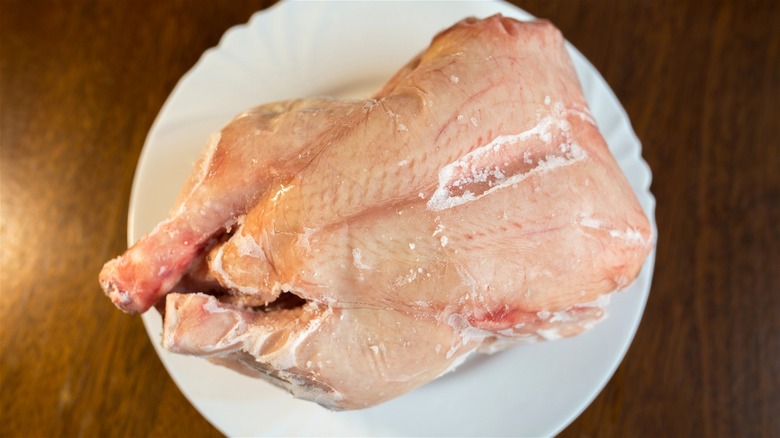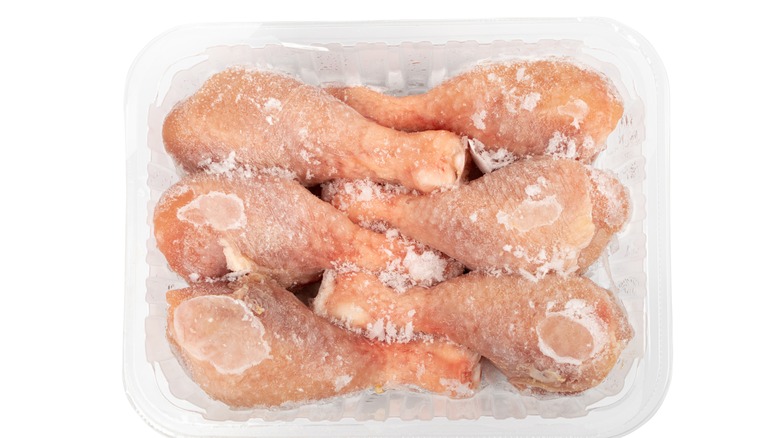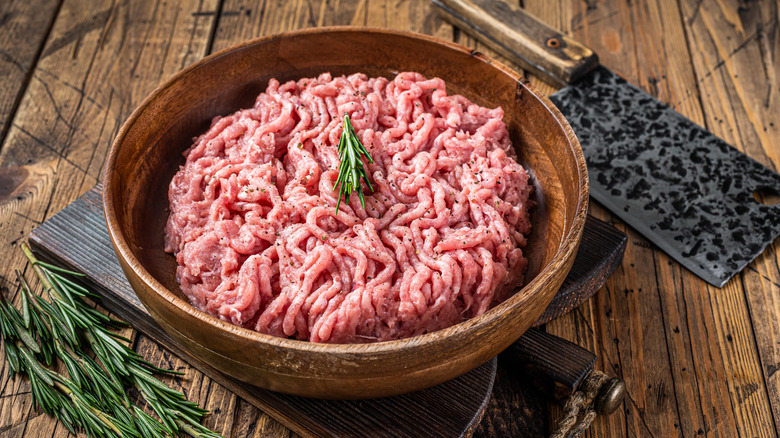Here's How Long Chicken Can Safely Be Frozen In Different Forms
While it's ideal to cook ingredients at their freshest, buying food in bulk and freezing it for later consumption is simply more convenient. Besides, its quality can be preserved through proper storage. When it comes to chicken and its different available forms in the market, each type has its own rules and methods that ensure not just the food's longevity but also overall food safety. Each form also has its respective storage life. According to the USDA, a properly frozen whole chicken can last for a year, portioned chicken parts for nine months, and ground chicken for three to four months. Cooked chicken dishes stay good in the freezer for four months and even six months for those that are sauce or gravy-heavy. Cooked chicken nuggets and patties, on the other hand, can be frozen for up to three months.
When buying raw chicken, you might wonder if it's better to buy fresh or frozen. Although there's a lingering reluctance to buy frozen meat due to its perceived inferiority in taste and quality, experts say it's better to buy industrially frozen poultry and stash it in the freezer. Fresh chicken loses moisture and nutrients while in transit from the supermarket to your home, and home freezers are no match for industrial ones. Waiting for it to get appropriately cold further contributes to the degradation of the chicken's quality. Consider these factors the next time you're in the meat section of the supermarket and planning to buy supplies in bulk.
Raw chicken must be stored at the bottom layer of the freezer
After purchasing raw whole chicken at the supermarket, wrap it with freezer paper with the papered side out as soon as you get home. This extra layer will protect the meat from moisture vapor, which will affect not just its quality and safety but also its taste and texture. For already-portioned poultry, divide and store it in meal-sized sections so you can thaw only what you need to cook. Wrap each piece in freezer paper before putting it inside a freezer bag, removing all air from the pouch before sealing it. This will make it easier to take out each cut for thawing and cooking. Using freezer paper is also better than air-tight containers because it conforms better to the chicken's irregular shape. You can wrap the meat snugly and leave no space for air, which is the main culprit behind freezer burn or the extreme loss of moisture in frozen food.
Raw poultry must always be stored at the bottom of the freezer, whether whole or portioned. This will minimize the possibility of its juices dripping down onto other food items and causing cross-contamination.
To thaw frozen chicken, place it in the refrigerator for 12 hours. This makes it safer to refreeze leftover raw chicken for later. Inspect the meat for any slimy film on its surface, a sour or ammonia-like smell, and a gray or brown pallor, which are indications of microbial growth.
Ground poultry must be sealed properly to keep its juices from leaking
Freezer bags are the best containers for storing ground poultry. Once you've put the meat inside one, release excess air by dunking the bag in a pan of cold water and then twisting and bending the top into a gooseneck knot. This will prevent any of the ground poultry's juices from leaking. Secure the bag closed and dry it completely before putting it in the freezer.
In terms of food safety and storage, the USDA also gives giblets, which are the organs and other body parts found inside the cavity of a chicken or turkey, the same three- to four-month timeframe as ground poultry. If you've bought giblets in bulk from the butcher, you don't need to clean them before storing. However, if they come from a whole chicken you've purchased, make sure to wash away any trace of fat, membrane, and blood on them before storing them separately. Once cleaned, seal the giblets inside an airtight container or freezer bag and put them in the freezer.
Just like with whole chicken, safely thaw frozen ground poultry and giblets by defrosting them in the refrigerator for 12 hours. Throw them out if they've turned gray in color or developed a viscous texture and an ammonia-like smell.
Different chicken dishes need different storage methods
Always let a dish cool down to room temperature before preparing it for storage. Do the same with store-bought rotisserie chicken, which shouldn't be stored in the bag it's sold in to avoid moisture buildup inside the container that'll encourage bacteria growth. Divide it into meal-sized portions for easier thawing later, and debone roasted or fried chicken.
For dishes that don't have sauce, like chicken patties, individually wrap each piece in aluminum foil before sealing them inside a freezer bag. Flash-freeze smaller items like chicken nuggets by placing them spaced apart on a baking sheet lined with parchment paper and putting them in the freezer. After an hour, transfer the nuggets into a freezer bag and return it to the freezer. For sauce-rich dishes like casseroles, cool them in the fridge for three to four hours before transferring them into a freezer-safe container. Place a layer of plastic wrap directly over the food, followed by a sheet of foil to protect it from freezer burn, then put the lid on the container. Cooked food must always be placed on the top shelf of the freezer, away from raw meat.
Thawing a frozen dish, especially casseroles, is safest when done overnight in the fridge. Dishes without sauce can also be defrosted using the quicker cold-water method: While still in the freezer bag, place the frozen food in a bowl of cold water. Replace the water every 30 minutes until the dish is completely defrosted. Discard the dish if the chicken has taken on a green or yellow tinge, a sour smell, and a slimy texture.



